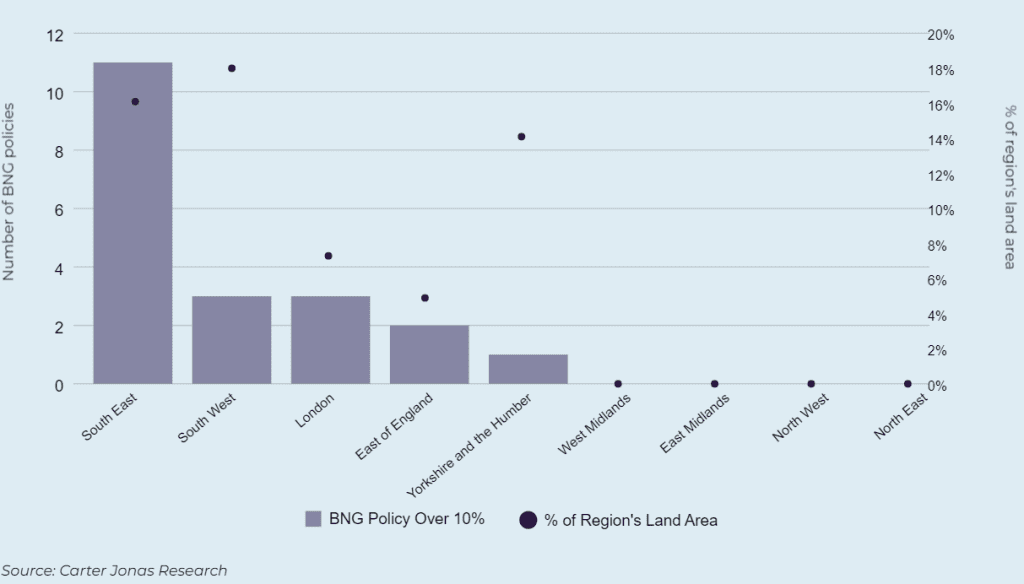As the requirement becomes compulsory
In advance of the statutory requirement for biodiversity net gain (BNG) for new developments from January 2024, Carter Jonas has analysed the emergence of BNG policies and guidance within local planning authorities (LPAs) in a series of research from spring 2022.
Carter Jonas’ Q4 2023 research of the 306 LPAs in England has revealed a gradual increase in the number requesting in excess of the 10% biodiversity net gain.
The local plans of Guildford, Brighton and Hove and Worthing (1% of all LPAs) require or encourage a percentage net gain higher than 10%. However, this figure is set to increase substantially as 17 (5.6%) have such a policy emerging through their local plan review. This is an increase of 33.3% from our Q4 2022 research.
Although not included in the analysis because of the early stage of adoption, numerous LPAs are actively considering a higher level of net gain, including Birmingham and Chelmsford.
Kingston Upon Thames and Tower Hamlets are set to have the most ambitious policies to date: both would require a minimum of 30% net gain but these policies are emerging through the local plan process and not yet adopted.

Commenting on the importance of the research, David Alborough, Natural Capital Consultant at Carter Jonas said, “Our analysis provides developers, landowners and planning consultants with valuable insight into where the greatest demand for off-site BNG is emerging, which has important implications for developers and identifies opportunities for landowners.”
Specifically, the research identifies some significant regional variations. BNG policies with a requirement in excess of 10% tend to be located in the south of England. In the South East, 11 LPAs have a BNG policy (either emerging or adopted) calling for greater than 10% net gain, accounting for 16.7% of LPAs in the region. This compares starkly to the North West, North East, West Midlands and East Midlands where no LPAs make this requirement.


Sophie Davidson, Associate in the Research Team explains, “Some regional variation can be attributed to the influence of Local Nature Partnerships, which is evident in the south. For example, the Kent Nature Partnership is promoting a county-wide target of 20% within Kent and Medway. In response to this, Kent County Council (with funding support from Natural England) commissioned a strategic viability assessment of BNG in Kent. The report concludes that the biggest cost in most cases is to get to 10% net gain, and the increase to 15% or 20% is ‘generally negligible’. This has influenced emerging policies in Sevenoaks, Maidstone, Canterbury and Swale so far, representing 30.7% of the county. Likewise, the Surrey Nature Partnership and Sussex Local Nature Partnership have directed higher net gain targets in their counties.”
In addition to showing an increasing number of LPAs deviating from the national position, either in the percentage net gain required or in their guiding framework for delivery, Carter Jonas’ research also identifies which LPAs are adopting measures to direct investment to local sites and accelerate the local market.
Sophie Davidson concludes, “In areas with higher net gain requirements, we can expect the local market to develop at a faster rate. Many LPAs have stalled their local plan reviews in the face of significant changes to national planning policy, so BNG policies have taken longer to develop than expected. But as changes are formalised and local plan reviews progress, expect to see more LPAs progressing higher levels of BNG. We are aware of several which have included an option to consider a greater scope for BNG in early consultations.
“Conversely, LPAs may drop their emerging 20% BNG policy before adoption. For instance, Rossendale Borough Council was seeking a 20% net gain in its draft submission but reduced the requirement to the statutory 10% in its final local plan.
“In the coming months, developers will be assessing their options and refining their BNG strategies. Meanwhile, demand for land for BNG will rise substantially, affording diversification opportunities for landowners.”
Building, Design & Construction Magazine | The Choice of Industry Professionals





